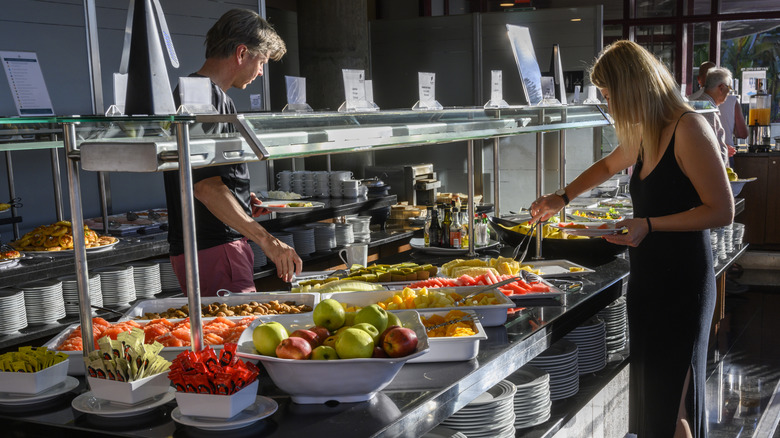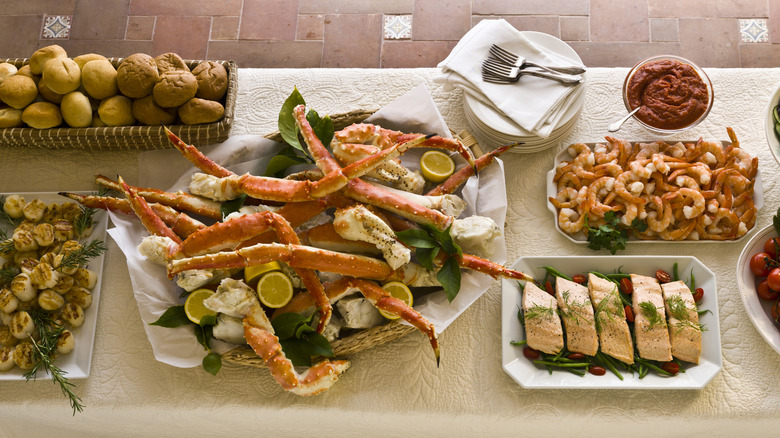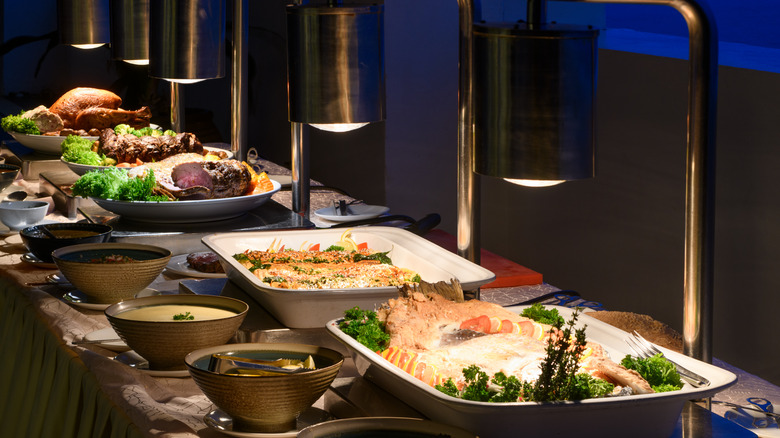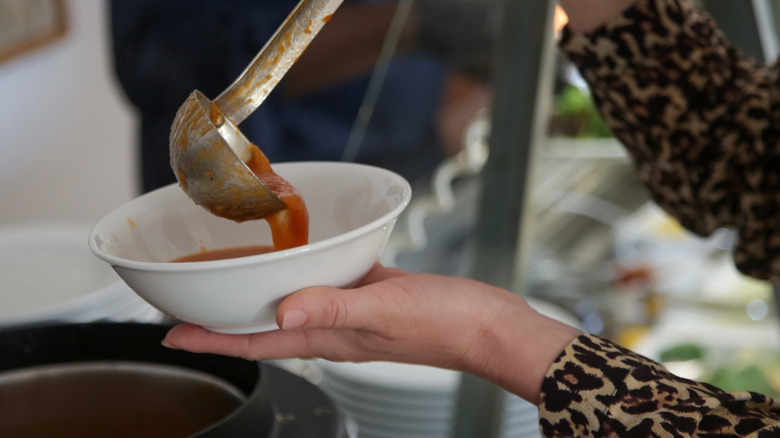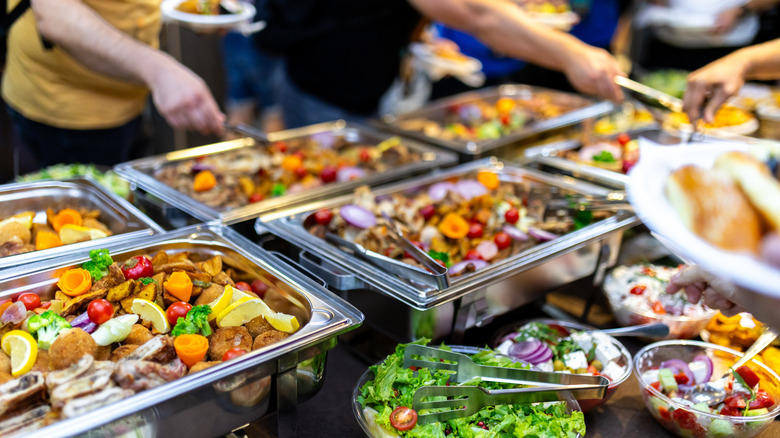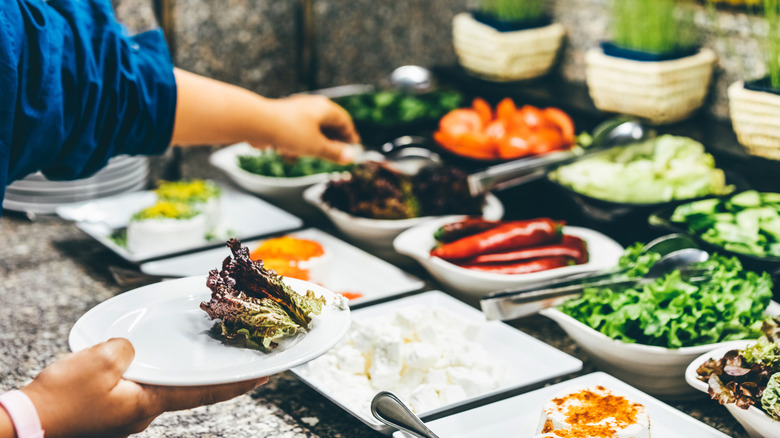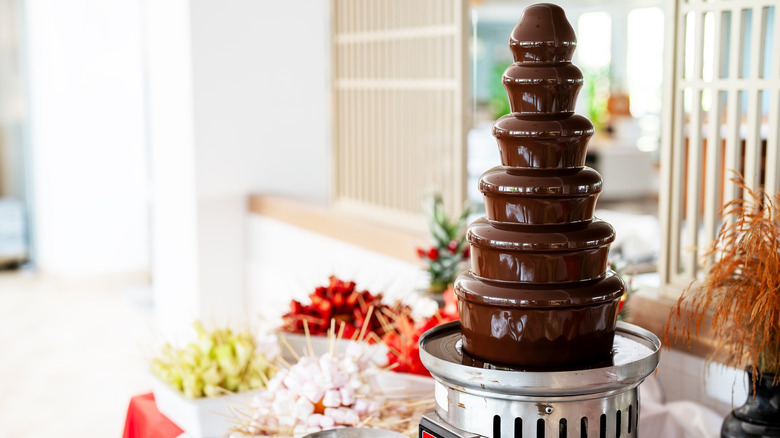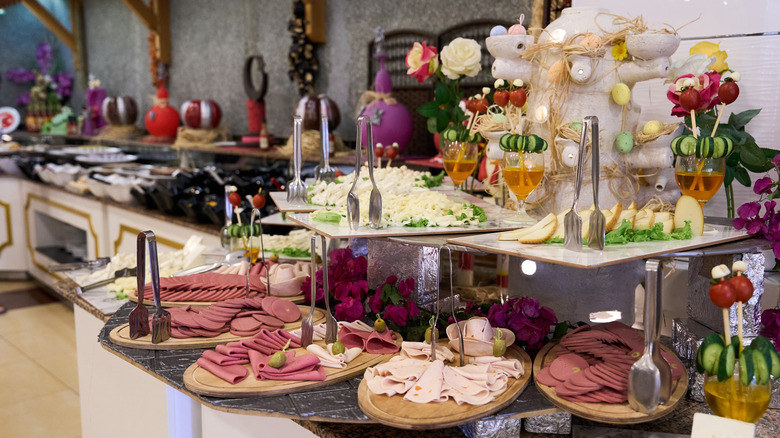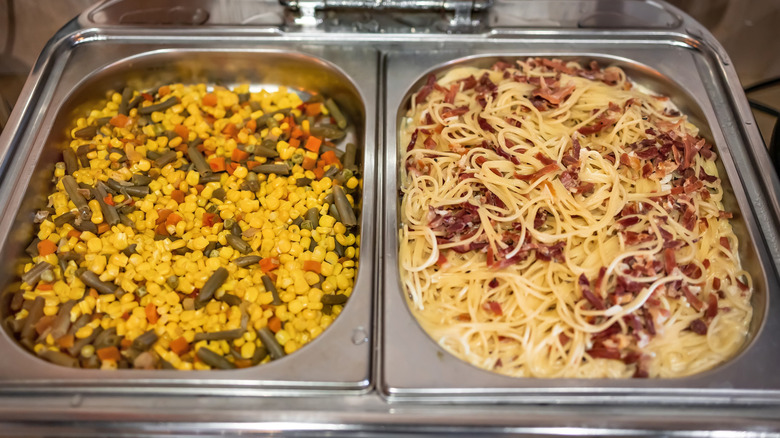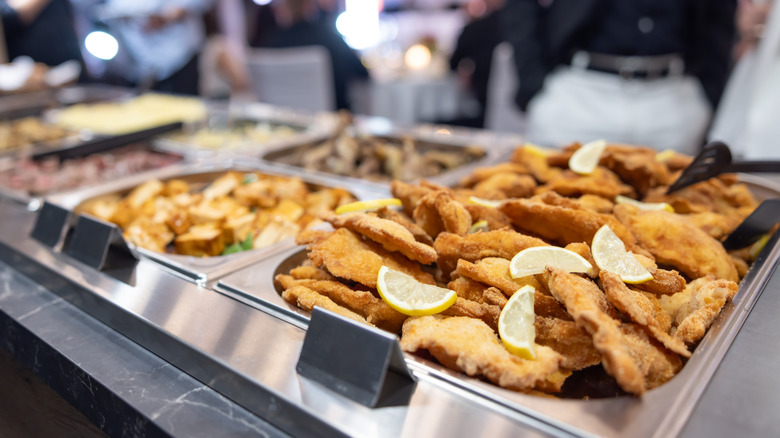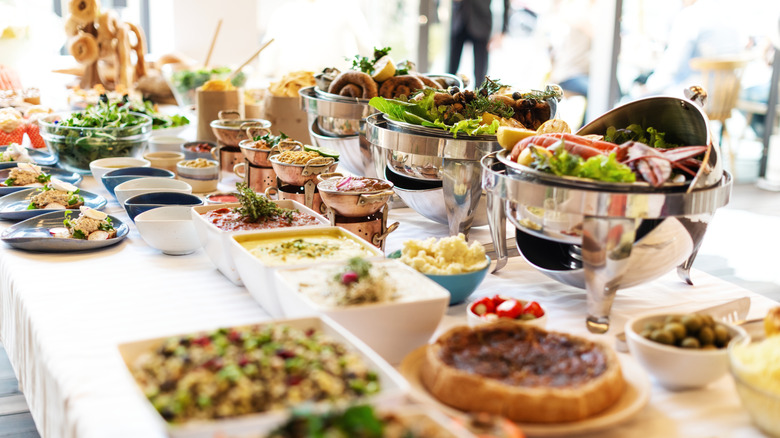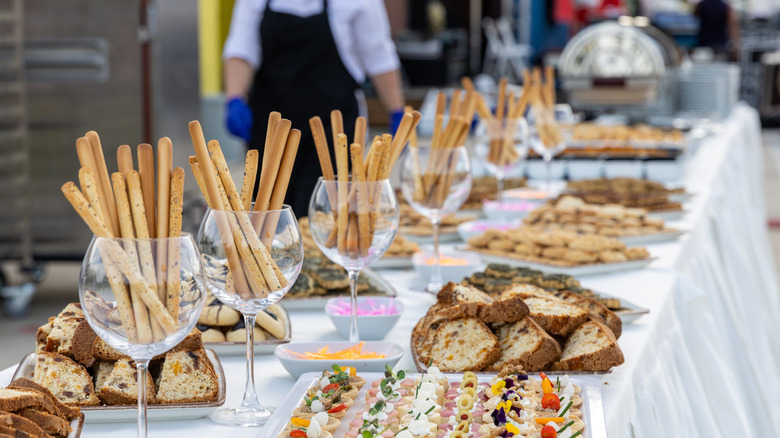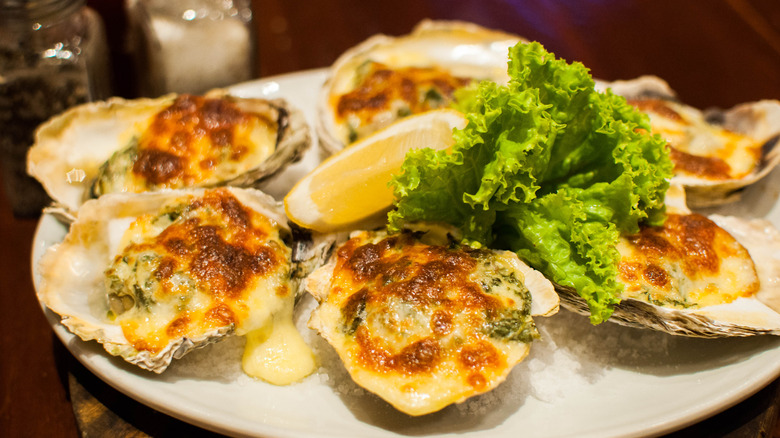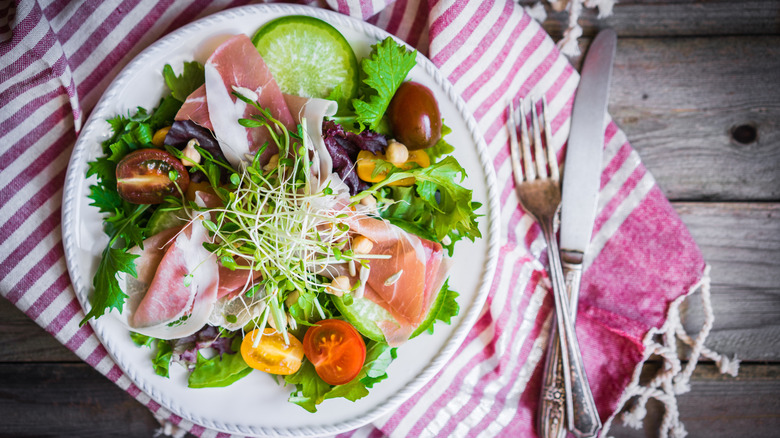What All-You-Can-Eat Buffets Don't Want You To Know About The Food
There's something about an all-you-can-eat buffet that's hard to resist. The trays spilling over with spaghetti, mountains of spring rolls, and ice cream machines surrounded by unlimited toppings. It's a feast without limits — at least until you hit your own. But buffets don't want you to think too hard about what's behind the sneeze guard.
We're not just talking about that dubious casserole that looks like it's been on the line since brunch. Buffets are finely tuned profit machines, engineered to fill you up cheaply. That towering pile of mashed potatoes you thought was a good idea to load onto your plate? That's there to fill you up with cheap starches. The crab legs you're eagerly reaching for? Well, those are likely bought for next-to-nothing and are far from fresh. And, if you come two days in a row, you might see the veggie side you ate the first day repurposed into soup on the second.
Now, we're not above the buffet hustle. If you want to go back for more food just because you can, more power to you — but you might not even want to eat there in the first place when you've seen how the sausage is made. Once you notice the sneaky tricks, you can't unsee them — like the pure strategy behind the layout forcing you past the salad bar before you find the prime rib. So, be aware of what these establishments don't want you to know. This buffet game isn't as bottomless as it looks.
The seafood is likely to be cheap
Here's a fun fact you probably didn't want to know: That seafood piled high under the fluorescent glow of a buffet line isn't top drawer. When "unlimited seafood" seems too good to be true, it probably is. So you might want to think twice about eating it at a buffet.
Some people say that the one food you should never put on your plate at a buffet is crab legs. Most all-you-can-eat establishments aren't shelling out (pun intended) for premium seafood. Instead, they're buying in bulk from fish markets where the crab legs are — let's just say, "at their peak" in the most generous sense. By the time they hit the warming tray, they've already been on a bit of a journey. A saga involving freezing, defrosting, and, occasionally, a little extra freezing for good measure.
And crab legs aren't the only buffet seafood getting this thrifty treatment. Those peel-and-eat shrimp you're dutifully piling onto your plate are likely frozen imports, pre-cooked and pre-seasoned in factories thousands of miles from anything resembling a coastline. Oysters are unlikely to be fresh either — particularly if you're eating them in the landlocked Midwest, where they will have hopped on more than one Greyhound to arrive from the ocean.
The trick here is psychology. Foods like oysters and crab legs seem luxurious, which makes you forget you're eating yesterday's markdowns. They won't feel so fancy if you spend the next 12 hours hugging the toilet bowl.
The food may have been sitting out for a while
One of the gross things you never knew about eating at buffets is that the food has probably been sitting there longer than you'd like to think. According to food safety guidelines, perishable food is only supposed to hang out in the "danger zone" (between 40 and 140 degrees Fahrenheit) for up to two hours before it's either chilled or tossed. But even so, that's a while to have been at room temperature, poked and prodded by fellow diners. Plus, not every buffet is going to follow these rules to the letter.
The buffet industry relies on the illusion of abundance, not necessarily freshness. That mac and cheese with the suspiciously crusty edges? Odds are it's been living its best lukewarm life for a couple of hours. And while some buffets do use warming trays to keep things at the right temperature, it's not a foolproof system. Food dries out, sauces congeal, and proteins get tough and leathery.
Your best bet with a buffet is to go soon after opening so that you're sure the food is about as fresh as it's going to get. Empty buffets are great for avoiding a queue but bad for freshness. The more customers a restaurant has, the quicker the food on the table is going to be eaten and replenished.
Buffet food may be reheated or repurposed another day
If you've ever wondered what happens to uneaten buffet food after the last plate is cleared, the answer isn't always "it goes in the trash." Waste is expensive and buffets are used to getting creative with leftovers. So, the food you're eating may have been seen another day.
Think that only fresh ingredients are used? Then you're falling for a common all-you-can-eat buffet myth. That tray of slightly limp vegetables might reappear tomorrow as soup. Those roasted potatoes you didn't grab? Diced, fried, and turned into breakfast hash. And let's not forget dessert. Stale dinner rolls have a way of transforming into bread pudding. Plus, some dishes are simply stored and put back out the next time.
It's not necessarily a bad thing. Restaurants repurpose food all the time, it's just that buffets take it to another level. This means that the food isn't always at its most delicious. The goal isn't to make it taste fresh — it's to make it look fresh. Plus, there's the food safety issue. In theory, any food that's put out the next day should have been hot-held at over 140 degrees Fahrenheit before being refrigerated overnight and reheated. But, in practice, this isn't always the case. Some unscrupulous restaurants try to avoid waste by reusing food that should be thrown out. So, if there's a buffet in your neighborhood with a bad reputation, it's best to avoid it.
There's inevitable contamination from fellow diners
Buffets are communal by nature. They're a place where strangers bond over bottomless mac and cheese and, unfortunately, shared germs. The real wild card at any buffet is your fellow diners. And not everyone is on their best behavior, so good luck out there.
For instance, tongs are meant to keep everyone's grubby hands out of the food, yet some people treat them as optional. There's always that one person who thinks grabbing a roll with their bare hand is fine because they're only touching one. Sure, Steve, but are you really? Now everyone else is touching whatever you didn't pick. And if everyone behaves themselves and uses the tongs, there's still the chance — no, the harsh reality — that someone hasn't washed their hands after going to the bathroom and then you've got your hands on the same utensils they've touched.
Then there's the coughing and sneezing. It's like nobody learned any lessons from COVID-19. Someone is always coughing right into the croutons at the salad bar. It's sadly inevitable. Let's not forget the kid running up to the dessert station and sticking their entire mouth over the soft-serve machine spout because, apparently, supervision isn't part of their parent's dining strategy. Remind us why we like buffets again?
Cross-contamination is a danger
Buffets can be a risk for anyone with food allergies or intolerances. The labels might say "gluten-free" or "nut-free," but what those signs can't account for is the behavior of other diners. And not everyone respects the rules of buffet hygiene, so cross-contamination is always a danger.
Tongs are supposed to stay with their designated dish, but somehow the ones from the cheesy garlic bread end up smack in the middle of the salad greens. Then, there's always someone who drizzles ranch all over the "dairy-free" section on the way to their plate. If you're lactose intolerant, suddenly that safe roasted cauliflower is a risky bet.
For diners with severe allergies, this lack of control can be genuinely dangerous. Even if you're hyper-vigilant, the sheer chaos of a buffet setup makes it hard to trust. In these cases, it may be best to avoid buffets. However if you end up there with family or for a work dinner, many kitchens are more than willing to prepare allergy-safe options separately if you ask. Unfortunately, at buffets, the burden of safety tends to fall on the person with the allergy.
The chocolate fountain may not be hygienic
Who isn't excited by a chocolate fountain? Sure, it's the literal stuff of childhood dreams — but it also may be unhygienic. We might not have a stack of studies to back this up, but the horror stories alone are enough to make you think twice before grabbing a skewer. You might be lucky and visit on a good day, but is it worth the risk?
For starters, there's always the kid who just has to touch it. Little fingers coated in who-knows-what poking into the fountain. And never forget that chocolate cycles round and round. What goes in, stays in. Then, there's the rogue diner who thinks the chocolate fountain is for any food on the buffet. You probably don't want to partake after it's had a chicken nugget dipped in its chocolatey depths.
We've also heard about non-food items taking a dip. We're not sure why someone wants to coat the cast on their broken wrist in chocolate but, allegedly, it's happened. So, perhaps it's better to steer clear and grab yourself a brownie or a bowl of Jell-O instead.
All kinds of bacteria and viruses can be lurking in buffet food
Buffets can contain more than just a mix of cuisines — they can also be laden with all kinds of bacteria and viruses. Most of the time, it's not dangerous. You might walk away with nothing more than a slightly queasy stomach. But more than 125,000 people a year are hospitalized from food poisoning, so it can get nasty.
Norovirus loves a good buffet. On cruise ships (where people eat buffet food more than they do out in the real world), it's not uncommon for a whole boatload of vacationers to be laid out by a shrimp cocktail. But basically anything that can be transmitted through saliva and the spray from coughs and sneezes is at play. That's probably a lot more than you bargained for.
And then there are nasty bacteria like E. coli, listeria, and salmonella. These aren't hanging out in every tray, of course. But all it takes is one improperly washed head of lettuce or undercooked piece of chicken to invite them to the party. Even the most careful operations are at the mercy of basic science. Hot foods that don't stay quite hot enough and cold foods that edge toward room temperature create ideal conditions for bacteria to flourish.
The cheaper stuff is placed earlier in the line
One of the things all-you-can-eat buffets don't want you to know is that they use tricks to fill you up. The placement of food is no accident. If you've ever wondered why you've filled most of your plate before you even spot the steak, you're onto something. And once you notice it, you can't unsee it.
Buffet restaurants load up the beginning of the line with cheap fillers. Mountains of pasta, baskets of bread, tempting fried rice, and plenty of salad and veggies. By the time you've navigated your way to the expensive stuff, you've already got a precarious stack of garlic knots and mac and cheese on your plate. Plus, some of the pricier things are hidden away so only the most dedicated buffet fans find it. You might find the prime rib hidden behind a pile of roasted potatoes or the sushi in the farthest corner, just past a suspiciously large tray of teriyaki chicken.
Buffet restaurants know you're unlikely to dump your plate mid-meal for another round, so they bet on you maxing out early. But, you can beat the system. Do a full lap before committing, letting the pasta and breadsticks wait while you scope out the premium goods. If you want to make the most of a buffet, you need to have a plan.
Fried foods at a buffet can be questionable
Fried foods at an all-you-can-eat buffet look good on paper, but reaching for them is one of the mistakes everyone makes at buffets. In reality, anything fried is usually disappointing. Now, don't get us wrong, we love good fried food — but this isn't it.
The buffet fryer setup is all about speed and volume, not quality. Most of it is fried en masse in cheap oil that's seen more batches than it should, which means the flavor leans more toward vague greasiness than anything appetizing. Fried foods should be fresh and crisp, but being cooked in this way makes them anything but.
And don't hold your breath for a batch that's straight out of the fryer — those mozzarella sticks were likely cooked hours ago and have been languishing under a heat lamp ever since. By the time you get to them, they're usually soggy. Anything breaded or battered will have become stodgy, while french fries are sad and floppy when they're not freshly fried. So do yourself a favor and leave the fried foods on the buffet table where they belong.
About half of the food at a buffet is wasted
Buffets may fill our plates and bellies, but they're also filling up garbage dumps. The dirty secret of all-you-can-eat is the sheer volume of food that ends up in the trash. By some estimates, about 50% of what gets served at buffets never gets eaten. It's about as far from eco-friendly dining as you can get.
It's not just the half-eaten crab legs or untouched piles of fried rice on people's plates that contribute to the problem. Buffets are constantly replenished to keep up the illusion of endless options. Once the night is over, anything that's been sitting out often gets tossed, whether it was touched or not. Sure, some food gets reheated or repurposed but much of it will have been sitting out for too long to be used again, according to food safety standards.
From an environmental perspective, this is a disaster. Food waste isn't just about the leftovers themselves. It's also the resources that went into producing them. That soggy loaf of garlic bread in the trash represents water, energy, and labor. Some food waste is inevitable in any restaurant, but buffets know wasting a large quantity of food is inherent in their business model and they do it anyway — not exactly something they want to shout from the rooftops.
Buffets serve starchy foods to fill you up
Buffets love a good starch. It's cheap, it's filling, and it keeps diners from eating their weight in the pricier stuff. The moment you approach the buffet line, you're greeted by starches. Rice pilaf, pasta salads, mashed potatoes, and bread rolls. And let's not forget the pizza slices, which are always conveniently stationed next to the mac and cheese — irresistible for a carb-lover.
It's no accident. Buffets rely on fullness math: The more room the rice and fries take up on your plate (and in your stomach), the less steak and sushi you'll devour. They do this on purpose to steer people toward eating more of the affordable foods and less of the expensive ones. Once your plate is full of mashed potatoes, you can't exactly put them back to make more room for something else. Well, you shouldn't, at least.
If you're determined to beat the system, skip the first few feet of the line, which is often wall-to-wall starches. But good luck resisting the garlic knots. Those buffet restaurants know us too well.
If food is covered in cheese, it might not be that fresh
The truth of all-you-can-eat seafood buffets is if something is covered in cheese, it probably isn't fresh. That lobster mac and cheese you were excited to see? It's 90% cheese sauce and breadcrumbs for a reason. Cheese has a remarkable ability to mask questionable textures and flavors, which is why it's the go-to disguise for seafood nearing its curtain call.
This isn't to say that every cheesy seafood dish is suspect. Some are crafted with care. But in a buffet setting where volume trumps quality, the strong flavor of cheese is a good way to improve a dish that wasn't up to much. If it's not seafood, it's the baked ziti drowning in mozzarella, or the cheesy broccoli casserole that tastes more Velveeta than vegetable.
And while cheese might cloak a lot, it can't do miracles. The texture is usually the giveaway. A rubbery scallop under a layer of gooey cheddar is still a rubbery scallop. So, enjoy cheese at a buffet, but remember what it's hiding. Sometimes it's better to go for the simpler options.
Sprouts aren't a good buffet choice
Raw sprouts might seem like the healthy choice at a buffet to balance out all that beige. But sprouts are risky business. They're prone to contamination and occasionally cause food poisoning so bad that it's fatal. They grow in warm, damp conditions, the same conditions that E. coli and salmonella call home. They also have lots of nooks and crannies around the seed casing the sprout grows from, making them difficult to clean effectively. As such, they're considered a high-risk food and should be avoided by anyone with a compromised immune system, including elderly folks and pregnant people.
At a buffet, they're an especially poor choice, as they may have just been rinsed clean and will have been sitting out for some time. And, honestly, they're just not worth it. Sprouts are great when they're fresh and crisp. But dumped into a buffet salad bar? They're usually limp, and tasteless. There are loads of other salad and veggie options if you want something on your plate that came from the ground.
